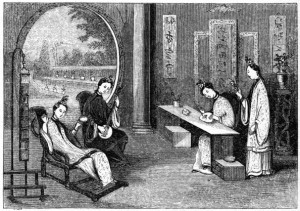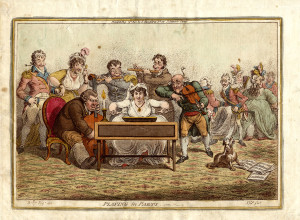P. Rohrbach, Musical Evening at Alexei Lvov Residence (The Brothers Vielhorski Quartet), 1840s, paper, lithography. St. Petersburg: The State Hermitage.
(Русская версия анонса идет после этого текста / Russian version see below)
The Musical Salon in Visual Culture
16th Conference of Association RIdIM
Rimsky-Korsakov Museum, St. Petersburg, Russia
7-9 September 2016
in collaboration with the Study Group “Musical Iconography” of the International Musicological Society, and sponsored by the St. Petersburg State Museum of Theatre and Music, and the Center for New Technology in the Arts “Art-parkING”
The musical salon is generally considered a social-cultural space, raising the need to examine a wide range of political, artistic, cultural and social issues. Accordingly it was, and still is, present in manifold areas of visual culture. While the social-cultural and musical facets of the salon have been treated with in-depth concerns for some time, broad and thorough evaluations of the visual manifestations of the musical salon still remain on the periphery of research, where they exist at all.
Manifestations of the musical salon in visual culture are not limited to nineteenth-century European music culture of course, although the typical musical genres often associated with this space, and as subsumed under the term salonmusik, emerged and grew popular in nineteenth-century Europe. In a broader sense, private musical spaces can be encountered prior to and after the nineteenth century and also outside of the geographical area of what is modern-day Europe. Likewise the visual manifestations of musical salons embrace a wide range of media, artistic genres and techniques and are to be viewed in private homes, museums, newspapers etc.
 Domestic scene, ladies at their usual employments, 1847. Chinese women painting and playing musical instruments. Illustration from The History of China and India, by Miss Corner (London: Dean and Co, 1847).
Domestic scene, ladies at their usual employments, 1847. Chinese women painting and playing musical instruments. Illustration from The History of China and India, by Miss Corner (London: Dean and Co, 1847).
The target of this Conference is this broader scope, and we invite abstracts for individual 30-minute papers in either English or Russian related to a global perspective of salon culture embracing all cultures and times. Considering the broad topical and methodological range of the subject we also very much welcome proposals for themed panel sessions (comprising three individual papers) and for round table sessions (up to six people, each presenting a position paper, followed by a discussion).
The proposed topics include but are not limited to:
- case studies of specific visual representations of musical salons.
- techniques and strategies to represent musical salons and their activity.
- the impact of the musical salon on society and culture as transmitted through the visual.
- the visualisation of music within depictions of musical salons.
- the visualisation of performance and organology matters within visual musical salon scenes.
- the role of gender, race and class in the visualisation of the musical salon.
- music and corporeal experience within the private space (as represented in the iconography of the musical salon).
- the visualisation of the sociability of the musical salon.
- the visualisation of emotions of the musical salon.
- the imaginary of the musical salon.
Abstracts in English along with a short biography should be submitted via the automatised application form following this link by 30 April 2016 (extended deadline). Successful applicants will be notified by 15 May 2016.
Presentations may be delivered in English or Russian.
There will be a registration fee of 75 Euro.

James Gillray, Playing in Parts, 1801, aquatint with engravings, 32 x 40.5, published 15 May 1801, by H. Humphrey, No 27 St. James’s Street, London.
Selected papers from the Conference may be published after the Conference. Authors may therefore need to ensure that any material presented is done so with the appropriate copyright clearance and that the paper presentation, or a version of it, has not been committed with a publisher. If there are any issues with this matter, please inform the organisers immediately following the submission of your paper proposal.
Programme Committee
- Dr Lidia Ader, Senior Researcher, Rimsky-Korsakov Museum (Chair)
- Prof Dr Antonio Baldassarre, President Association Répertoire International d’Iconographie Musicale
- PD Dr Dorothea Baumann, University of Zurich
- Dr Zdravko Blažeković, Director Research Center for Music Iconography, City University of New York
- Dr Nicoletta Guidobaldi, Chair IMS Study Group “Musical Iconography”
- Alexei Kossykh, MA, Research Assistant, Collegium Organologicum Boreale
To submit a paper proposal please fill in the application form following this link.
МУЗЫКАЛЬНЫЙ САЛОН В ВИЗУАЛЬНОЙ КУЛЬТУРЕ
XVI Международная конференция
Ассоциации «Международный каталог музыкальной иконографии» (RIdIM)
7–9 сентября 2016 года Ассоциация RIdIM, совместно с Музеем-квартирой Н. А. Римского-Корсакова в Санкт-Петербурге, Исследовательской группой по музыкальной иконографии Международного музыковедческого общества (IMS) и при поддержке Санкт-Петербургского государственного музея театрального и музыкального искусства и Центра современных технологий в искусстве «Арт-паркИНГ», проводит международную конференцию «Музыкальный салон в визуальной культуре».
Рабочие языки: английский и русский.
Место проведения: Музей-квартира Н. А. Римского-Корсакова, Санкт-Петербург.
Заявки принимаются до 1 апреля 2016 г.
Социокультурное пространство музыкального салона привлекает внимание специалистов широкого круга – политологов, социологов, музыковедов и культурологов. Вместе с тем существующая иконография салонной культуры расширяет спектр изучаемых вопросов и привлекает ученых в области визуальной культуры. Несмотря на высокий интерес к музыкальному салону как таковому, его обширная иконография до сих остается на периферии исследовательских штудий.
Визуальные репрезентации музыкального салона конечно же не ограничиваются европейской музыкальной культурой девятнадцатого столетия, хотя в это время в Европе и появились и набрали популярность типичные жанры салонной музыки, обычно ассоциирующиеся с пространством салона. В более широком понимании домашние музыкальные пространства можно обнаружить и до, и после девятнадцатого века, и за пределами современных европейских границ. Применительно к музыкальному салону существует богатая традиция средств визуальной трансляции, разнообразие художественных жанров и техник, их изображения можно видеть в частных домах, музеях, печатных изданиях и т. д.
Такое широкое понимание визуализации музыкального салона и является основным предметом дискуссий в рамках работы настоящей конференции. К обсуждению предлагаются следующие темы (список открыт):
- исследования изображений конкретных музыкальных салонов;
- техники и стратегии изображения музыкальных салонов и их быта;
- влияние музыкального салона на общество и культуру, транслируемое через визуальную сферу;
- визуализация музыки в изображениях музыкальных салонов;
- визуализация музыкального исполнительства и музыкальных инструментов в изображениях сцен салонного музицирования;
- роль гендерной / национальной / классовой идентичности в визуальной репрезентации музыкального салона;
- визуальные репрезентации музыки и телесности в частном пространстве музыкального салона;
- визуализация социабельности музыкального салона;
- визуализация эмоций музыкального салона;
- воображаемое музыкального салона.
Оргкомитет принимает заявки на индивидуальные доклады (30 мин.), тематические секции (3 доклада по 30 мин.) и круглые столы (до 6 докладов, с последующим их обсуждением).
Для участия в конференции необходимо до 30 апреля 2016 г. отправить через электронную форму https://ridim.org/application-form-ridim-2015-conference/ тезисы доклада и краткие сведения об авторе(ах) на английском языке. Авторы принятых заявок будут уведомлены не позднее 15 мая 2016 г.
Доклады могут быть представлены на английском и русском языке.
Оргкомитет конференции:
- к.иск. Лидия Адэр, с.н.с., Музей-квартира Н. А. Римского-Корсакова (председатель);
- проф., д-р Антонио Бальдассаре (Antonio Baldassarre), президент Ассоциации «Международный каталог музыкальной иконографии» (RIdIM);
- адъюнкт-проф., д-р Доротея Бауманн (Dorothea Baumann), Университет Цюриха (UZH);
- д-р Здравко Блажекович (Zdravko Blazekovic), директор Исследовательского центра по музыкальной иконографии в Городском университете Нью-Йорка (CUNY);
- д-р Николетта Гвидобальди (Nicoletta Guidobaldi), председатель Исследовательской группы по музыкальной иконографии Международного общества музыковедения (IMS);
- магистр филологии Алексей Косых, научный ассистент, Collegium Organologicum Boreale.

